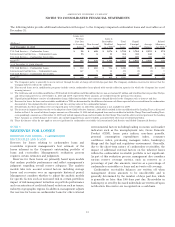American Express 2010 Annual Report Download - page 76
Download and view the complete annual report
Please find page 76 of the 2010 American Express annual report below. You can navigate through the pages in the report by either clicking on the pages listed below, or by using the keyword search tool below to find specific information within the annual report.
Software development costs
The Company capitalizes certain costs associated with the
acquisition or development of internal-use software. Once the
software is ready for its intended use, these costs are amortized
on a straight-line basis over the software’s estimated useful life,
generally 5 years.
OTHER SIGNIFICANT ACCOUNTING POLICIES
The following table identifies the Company’s other significant accounting policies, the Note and page where a detailed description of
each policy can be found.
Significant Accounting Policy
Note
Number Note Title Page
Fair Value Measurements Note 3 Fair Values Page 76
Accounts Receivable Note 4 Accounts Receivable and Loans Page 78
Loans Note 4 Accounts Receivable and Loans Page 78
Reserves for Losses Note 5 Reserves for Losses Page 81
Investment Securities Note 6 Investment Securities Page 83
Securitization Income, Net; and Asset Securitization Note 7 Asset Securitizations Page 85
Goodwill and Other Intangible Assets Note 8 Other Assets Page 87
Membership Rewards Note 11 Other Liabilities Page 92
Derivative Financial Instruments and Hedging Activities Note 12 Derivatives and Hedging Activities Page 92
Income Taxes Note 17 Income Taxes Page 101
Other Non-Interest Revenues Note 19 Details of Certain Consolidated Statements of Income Lines Page 103
Other, Net Expense Note 19 Details of Certain Consolidated Statements of Income Lines Page 103
Stock-based Compensation Note 20 Stock Plans Page 104
Legal Contingencies Note 24 Commitments and Contingencies Page 113
Reportable Operating Segments Note 25 Reportable Operating Segments and Geographic Operations Page 114
RECENTLY ISSUED ACCOUNTING STANDARDS
The Financial Accounting Standards Board (FASB) recently
issued Accounting Standards Update (ASU) No. 2010-20,
Receivables (Topic 310): Disclosures about the Credit Quality
of Financing Receivables and the Allowance for Credit Losses.
This standard is intended to provide additional information to
assist financial statement users in assessing an entity’s credit risk
exposures and evaluating the adequacy of its allowance for credit
losses. As such, the standard amends existing guidance by
requiring an entity to provide a greater level of disaggregated
information about its financing receivables and its allowance for
credit losses and includes new disclosures such as credit quality
indicators, past due information and additional impaired loan
data. Effective December 31, 2010, the Company adopted these
amendments except for disclosures of activity within periods,
which become effective for periods beginning January 1, 2011.
Additionally, certain new disclosures for Troubled Debt
Restructurings were not implemented because such
disclosures have been deferred by ASU No. 2011-01,
Receivables (Topic 310): Deferral of the Effective Date of
Disclosures about Troubled Debt Restructurings in Update
No. 2010-20, and are expected to be effective for periods
beginning April 1, 2011.
In addition, the Company adopted the following standards:
•ASU No. 2009-16, Transfers and Servicing (Topic 860):
Accounting for Transfers of Financial Assets, and
•ASU No. 2009-17, Consolidations (Topic 810): Improvements
to Financial Reporting by Enterprises Involved with Variable
Interest Entities.
These standards (generally referred to herein as new GAAP
effective January 1, 2010) eliminated the concept of a qualifying
special purpose entity (QSPE), therefore requiring these entities
to be evaluated under the accounting guidance for consolidation
of VIEs. In addition, ASU 2009-17 required an entity to
reconsider its previous consolidation conclusions reached
under the VIE consolidation model, including (i) whether an
entity is a VIE, (ii) whether the enterprise is the VIE’s primary
beneficiary, and (iii) the required financial
statement disclosures.
Upon adoption of ASU 2009-16 and ASU 2009-17, the
Company was required to change its accounting for the
American Express Credit Account Master Trust (the Lending
Trust), a previously unconsolidated VIE, which is now
consolidated. As a result, beginning January 1, 2010, the
securitized cardmember loans and related debt securities
issued to third parties by the Lending Trust are included on
the Company’s Consolidated Balance Sheet. The Company
continues to consolidate the American Express Issuance Trust
(the Charge Trust). Prior period results have not been revised
for the change in accounting for the Lending Trust. Refer to
Note 7 for further discussion.
74
AMERICAN EXPRESS COMPANY
NOTES TO CONSOLIDATED FINANCIAL STATEMENTS
























